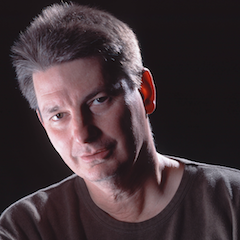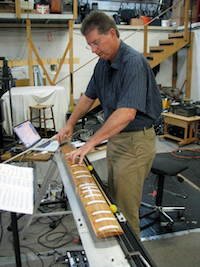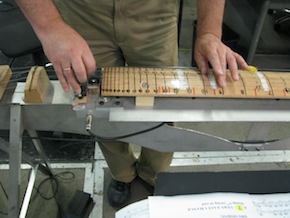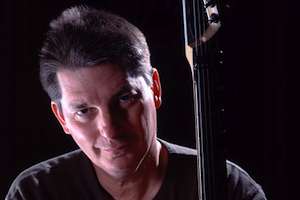
Like so many of the ‘invented instruments’ that Paul Dresher has created during his career, the Quadrachord was built specifically for one show — in this case the musical theater production Sound Stage, performed in 2001 by a group called Zeitgeist in Minneapolis. “When I was composing music for that show, I soon realized that this instrument had a rich potential that could go way beyond what I was writing for that occasion. So I started using the Quadrachord in duo performances with percussionist Joel Davel and wrote some chamber music for it.”
It could be interpreted as a sign of maturity for the instrument that the Berkeley Symphony has now commissioned Paul Dresher (b. 1951) to write a Concerto for Quadrachord and Orchestra, which will be premiered during the season opening concert on Oct. 4. “I have always wanted to see how far I could go with this instrument,” says Dresher in his cavernous workshop/studio/rehearsal space in Oakland. There is a depth and richness to its potential that could work with an orchestra.”
Raw Funkiness
An ‘invented instrument’ is typically made out of found or recycled materials and the Quadrachord is no exception. Dresher built it ‘from scrap’, together with his friend and fellow instrument designer Daniel Schmidt. They were looking for ‘raw funkiness, rather than a refined sense of beauty’ when they built the Quadrachord. In its current form, which dates from 2004, it looks like a big aluminum I-beam with four metal strings (hence the name quadra-chord) stretched along the top; the whole instrument is about 16 feet long and the strings measure 140 inches. “Like an electric guitar, it produces very little sound of its own,”says Dresher. “There are bass pickups underneath the strings and the sound runs through signal processing equipment that is similar to what you would use for an electric guitar.” Dresher, who considers himself a ‘credentialed rock-and-roller’ (“I still play the electric guitar”), plucks the strings of the Quadrachord, but also uses a double-bass bow and all kinds of mallets, sticks and other percussion tools on the instrument. The sound he is able to generate resembles anything from a cello playing in a high register, to a slapped bass guitar or the low drone of an early Moog synthesizer.
Lumber Yard

Photos by Niels Swinkels
“The first version of the Quadrachord was entirely made out of wood; it actually sounded better,” says Dresher. “We used solid wood; there was no resonating chamber, but the wood imparted a warmth to the sound that I was able to restore — but only in part — with electronics. If I had to travel with the Quadrachord, I would just bring both ends of the instrument and visit a local lumber yard to buy a twelve-foot two-by-six and a 10-foot two-by-four. It would take an hour-and-a-half of carpentry to put the whole thing together.” A concert in Carnegie hall in New York was the reason to create a new version of the Quadrachord. “Going to a lumber yard in New York City is not very practical, so we made a portable version out of aluminum. It breaks down into two cases and takes 45 minutes to set up. I just check it as luggage. The TSA is always puzzled by it, but at least they figure out quickly that it is not a bomb.”
Musing
After about a decade of performing with the Quadrachord, Dresher has mastered the instrument and he knows what its possibilities and limitations are. But creating a Concerto for the Quadrachord is quite another thing. “I did a lot of thinking about it, and a lot of musing about what approach to take. Initially I wanted to include another of my invented instruments, the Hurdy Grande [as the name suggests, indeed a mega-sized kind of hurdy-gurdy, nsw] but as I started to compose, I soon had so much strong material that I decided to focus on just one instrument.”
Generic

“The material for this composition all originates from the instrument itself,” says Dresher. “There is no program, or contrasting musical themes; the concerto is just about the relationship between this instrument and the orchestra. I was looking for a single encompassing name for my piece that was less generic than Concerto for Quadrachord and Orchestra, but nothing came up. The titles of the individual movements came very easily and are more evocative, because they were relevant to what I was grappling with in each section. The first movement is titled "Uncommon Ground"; it is very dense and rich and resonant, and rhythmically complex and layered. You can interpret the title both ways: the orchestra and the Quadrachord do not have common ground but at the same time also an unusual common ground. The second movement, "A Tale of Two Tunings." It is very spare, with stretching and shifting harmonics, exposing the different tunings between the orchestra and me in the most raw way. The final movement is "Louder/Faster," and has a throbbing rhythmic energy. In this part I am mostly drumming on the Quadrachord.”
Ghetto
Dresher’s new piece is programmed in between Charles Ives’ The Unanswered Question and Beethoven’s Symphony No. 7. Is that where Paul Dresher wants to be? Or belongs? He laughs. “Any discussion of these things can become very pretentious very quickly. This is what the Berkeley Symphony does, and what the Berkeley audience expects. But I have actually been programmed with Beethoven a lot of times, both in previous orchestra pieces and in some of my chamber works. And I think that’s great. I am honored to not be ghettoized in just a contemporary music concert. I feel that my work is in a continuity of the classical music tradition. It draws from pop music; I have played rock and roll professionally; I have studied and played a lot of world music, so a lot of other influences come into my musical vocabulary, but if you write notes on paper for musicians to play, you are probably connected to that lineage of European classical music. Jazz people could take issue with that, but I feel that I am rooted in that European classical tradition. I love to be on programs with other parts of that repertoire.”

